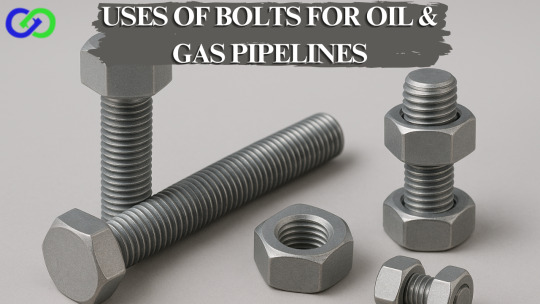#PipelineBolts
Explore tagged Tumblr posts
Text
Uses of Bolts for Oil & Gas Pipelines

Introduction
In the oil and gas industry, pipelines serve as the lifelines for transporting crude oil, natural gas, and refined products over long distances. These critical infrastructures demand components that ensure safety, durability, and performance under extreme conditions. Bolts, though small in size, play a vital role in the assembly, integrity, and maintenance of oil & gas pipeline systems.
This blog delves into the importance, various types, and specific applications of bolts in oil and gas pipeline systems.
Importance of Bolts in Oil & Gas Pipelines
Bolts are critical mechanical fasteners that securely connect two or more components. In oil and gas pipeline systems, they serve to:
Secure flange connections
Support valve assemblies
Withstand high pressure and temperature
Resist corrosion from harsh chemicals and environmental conditions
Enable easy maintenance and disassembly
Any failure in bolted joints could result in leaks, production downtime, or safety hazards, making bolt selection and installation critical to pipeline integrity.
Key Applications of Bolts in Oil & Gas Pipelines
1. Flanged Connections
Used to bolt two pipe ends together using gaskets.
Ensure tight sealing in high-pressure, high-temperature environments.
They typically use high-strength stud bolts and nuts in accordance with ASME B16.5 or B16.47 standards.
2. Valve Installation
Bolts attach valves to pipelines, allowing for effective regulation of flow and pressure within the system.
They must withstand frequent operation and significant mechanical stress.
3. Compressor & Pump Stations
They anchor rotating machinery like pumps and compressors to the pipeline system, ensuring stable and reliable operation.
Require vibration-resistant bolts with high tensile strength.
4. Manifolds & Headers
Bolts connect complex pipe networks for distributing or collecting fluids.
Used in both upstream and downstream systems.
5. Pipeline Supports and Anchors
Anchor bolts fix supports that carry the pipeline’s weight and thermal expansion.
Must withstand static and dynamic loads.
Types of Bolts Used in Oil & Gas Pipelines
Stud Bolts
Common in flange connections; used with two nuts
Hex Head Bolts
Used in areas requiring easy access for tightening
Anchor Bolts
Secure pipelines and equipment to concrete foundations
U-Bolts
Support pipes in hangers or saddle mounts
Heavy Hex Bolts
Provide additional contact surface for high-load applications
Material Considerations for Oil & Gas Pipeline Bolts
Pipelines are often exposed to corrosive environments, including:
Sour gas (H₂S presence)
Saline offshore environments
High-temperature fluids
Acids and hydrocarbons
Common Materials Used:
Carbon Steel (B7)
High tensile strength; cost-effective; used in non-corrosive environments
Stainless Steel (316, 304)
Good corrosion resistance; suitable for moderate environments
Duplex / Super Duplex
Excellent corrosion resistance and strength; ideal for offshore use
Inconel / Monel / Hastelloy
For extreme conditions involving acids, heat, or seawater
PTFE or Xylan Coated Bolts
Enhanced resistance against galling and corrosion
Industry Standards for Pipeline Bolts
Bolts used in oil & gas pipelines must meet stringent international standards, such as:
ASTM A193 / A194 – For high-temperature and pressure service
ASME B16.5 / B16.47 – Flange dimensions and bolting
API Standards – For pipeline construction and pressure testing
Conclusion
Though often overlooked, bolts are critical components in the oil and gas pipeline infrastructure. Their correct selection, installation, and maintenance ensure the safety, reliability, and longevity of pipeline systems in some of the world’s harshest environments. From securing flange joints to supporting heavy equipment, bolts must be engineered to withstand extreme mechanical and chemical stresses.
Ananka Group offers a wide range of high-performance bolts that meet the demanding specifications of the oil and gas industry. With precision manufacturing, premium materials, and adherence to international standards, our fasteners are trusted in pipeline projects around the world.
FAQ
Q1: What are the different types of bolts used in oil and gas pipeline systems?The most commonly used bolts include stud bolts with heavy hex nuts, hex head bolts, and anchor bolts, particularly for flange connections, valve installations, and structural support.
Q2: Why is material selection important for pipeline bolts?Pipeline environments involve high pressure, extreme temperatures, and corrosive media like H₂S or saltwater. Material selection ensures the bolts can withstand these conditions without failure, enhancing safety and reliability.
Q3: What standards govern bolts for oil & gas pipeline applications?Key standards include ASTM A193 / A194 for high-pressure and high-temperature bolting, ASME B16.5/B16.47 for flanges, and NACE MR0175/ISO 15156 for sour gas corrosion resistance.
Q4: Are stainless steel bolts suitable for all oil and gas pipeline environments?Not necessarily. While stainless steel offers good corrosion resistance, environments with sour gas or extreme salinity often require more specialized materials like Inconel, Monel, or Super Duplex.
Q5: What types of coatings are applied to pipeline bolts to enhance corrosion resistance?Common protective coatings include PTFE (Teflon), Xylan, hot-dip galvanizing, and zinc plating, which enhance corrosion resistance and ease of installation.
Q6: How are bolt failures prevented in pipeline systems?By using the correct material grade, applying proper torque during installation, following maintenance schedules, and ensuring compliance with relevant engineering standards and certifications.
Q7: What is the role of stud bolts in pipeline flange assemblies?Stud bolts provide even clamping force across the flange face when used with heavy hex nuts, ensuring a leak-proof and secure connection in high-pressure pipeline systems.
Q8: Can coated bolts be used in subsea pipeline systems? Yes, but the coating and base material must be selected carefully. In subsea applications, corrosion-resistant alloys like Super Duplex or Inconel, often coated with PTFE or Xylan, are preferred for longevity and performance.
#OilAndGas#PipelineBolts#IndustrialFasteners#HighStrengthBolts#PipelineConstruction#StudBolts#ASMEBolts#ASTMA193#HeavyHexNuts#AnankaFasteners#BoltsAndNuts#OilAndGasEngineering#Ananka#Articles#Blog#tumblr blog#tumblr
0 notes